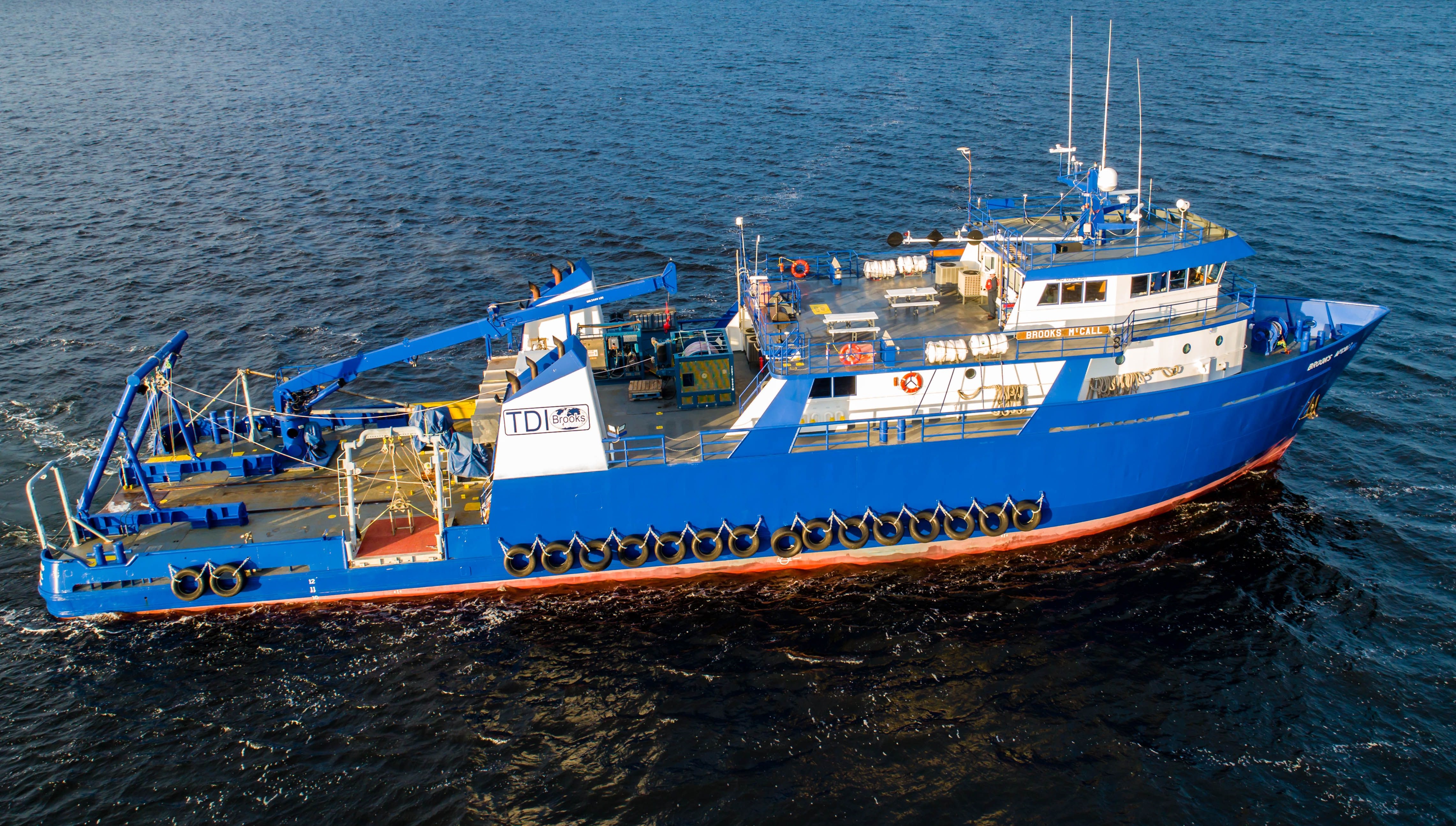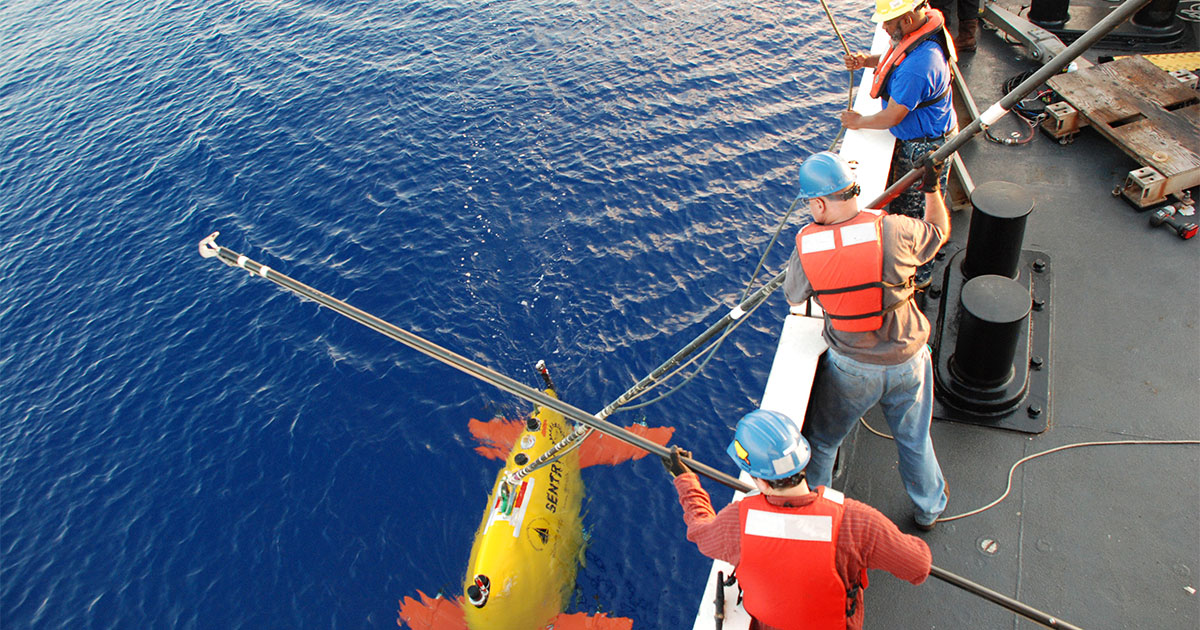As the charge towards net-zero goals fuels the offshore renewable industry, the need for collaborative, multidisciplinary marine exploration persists. With the development of offshore wind in the northeast region of the US advancing, back in 2017 the Bureau of Ocean Energy Management (BOEM), the National Oceanic and Atmospheric Administration (NOAA) Office of Ocean Exploration and Research (OER), and the US Geological Survey (USGS) awarded TDI-Brooks a contract for a five-year collaborative scientific research program focused on the outer continental shelf between Virginia and Georgia. This program’s focus was on hard substrate habitats, but also included research relating to soft bottom and water column habitats.
A Tech-Supported Investigation
There were four main aims for the study: (1) explore and characterize the biological communities of the study area; (2) examine the sensitivity of habitat-structuring fauna and associated communities to natural and anthropogenic disturbance; (3) describe the oceanographic, geological, and geochemical conditions associated with each habitat type; and (4) model the distribution of habitats and fauna with respect to environmental conditions.
To meet these four goals, five directly supported cruises were carried out to develop detailed site descriptions of the geological, physical, chemical, and biological conditions found. These cruises were facilitated through the use of various research vessels and robotic technology: NOAA’s ships Pisces with autonomous underwater vehicle (AUV) Sentry, Nancy Foster, and Ron Brown with remotely operated vehicle (ROV) Jason; TDI-Brooks’ Research RV Brooks McCall; and Woods Hole Oceanographic Institution’s (WHOI) RV Atlantis with deep submergence vehicle (DSV) Alvin were included.

TDI-Brooks’ RV Brooks McCall performed one of five directly supported cruises for deepwater habitat characterization. (Image credit: TDI-Brooks)
The research results, analyses, and findings include the oceanographic, geological, and geochemical setting of canyons, seeps, and coral environments, deep-sea soundscapes, community structure and trophic function from microbes to fishes, population connectivity, life history of selected species, habitat suitability modeling deep-sea corals and seeps and educational outreach to the public.
Conclusive Study
TDI-Brooks’ final report, Deepwater Atlantic Habitats II: Continued Atlantic Research and Exploration in Deepwater Ecosystems with Focus on Coral, Canyon, and Seep Communities, for the DEEP SEARCH contract issued by the US Department of the Interior and Bureau of Ocean Energy Management (BOEM) was recently submitted. TDI-Brooks surveyed the region’s deep-sea coral, cold-seep, and canyon communities as habitats of focus with the overarching goal of improving our understanding of the functional role of these three habitat types in order to advance scientific knowledge and inform future management decisions. The intended application of the new science was to develop better predictive capacities for the community types encountered.

DEEP SEARCH area showing BOEM wind leases NOTE: along with protraction areas, methane seeps, L. pertusa sites, and deep-sea coral Habitat Area of Particular Concern. (Image credit: TDI-Brooks)
The sites were studied during five directly supported cruises, with detailed site descriptions of the geological, physical, chemical, and biological conditions encountered. The results from six additional cruises conducted through collaboration with the ADEON project and NOAA-OER also contributed to the DEEP SEARCH database. The research results, analyses, and findings include the oceanographic, geological, and geochemical setting of canyons, seeps, and coral environments, deep-sea soundscapes, community structure and trophic function from microbes to fishes, population connectivity, life history of selected species, habitat suitability modeling deep-sea corals and seeps and educational outreach to the public.
Some of the more significant findings that have been produced from this study:
- The newly named Richardson Reef Complex is now understood to be one of the largest cold-water coral reef complexes in the world. Furthermore, the Richardson Reef Complex is part of one of the largest coral mound provinces in the world, the Million Mounds, which extends from Richardson in the northeast and south across the entire Blake Plateau and down along the Florida coast to the Jacksonville Mounds.
- The seeps along the continental shelf edge, visited for the first time, are remarkable for their extremely high rates of methane release and oxidation. Their chemistry fuels biological productivity that appears to also support local pelagic communities.
- Pamlico Canyon was found to be home to a very high diversity coral assemblage, to have high overall diversity of infauna, and to exhibit some of the highest densities of sediment infauna we have observed at this depth.
- Deep SEARCH data indicates high connectivity among all habitat and community types. For example, we see interactions between the diel vertical-migrating mid-water community and the benthic zone of the Richardson Reef Complex, as well as those of midwater organisms with the walls of the canyons and shallow seeps.
- The unique oceanographic conditions in the region have a corresponding influence on the various communities. The Gulf Stream cuts through the center of the study area, causing vertical mixing in its core down to 1,000 m. This promotes a rapid translation of food to depth and nutrients to the surface, which brings elevated trophic and genetic connectivity of the components of the ecosystem. These currents are highly variable at the seabed, (apparently) inducing a high degree of adaptive resilience of the deep-sea corals of the region in response to rapidly changing environmental conditions.
Through this study, TDI-Brooks has filled major data gaps for poorly known deep-sea ecosystems, aiding the refinement of regional management strategies. Our improved understanding of the habitats and communities in offshore areas of the Atlantic Large Marine Ecosystem augments the capacity to predict the distribution of sensitive areas concerning the potential development of energy and marine minerals managed by the Bureau of Ocean Energy Management.
To find out more about TDI-Brooks and their multidisciplinary services, visit: https://www.tdi-bi.com/
This feature appeared in Environment, Coastal & Offshore (ECO) Magazine's 2023 Autumn edition Multidisciplinary Environmental Projects, to read more access the magazine here.





